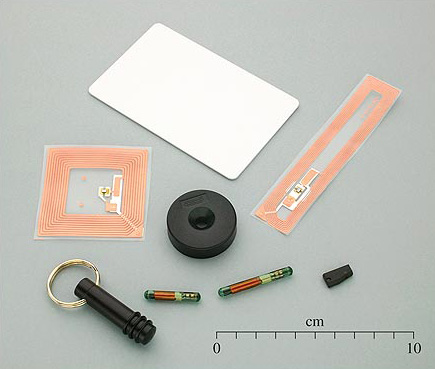7.4 Understanding RFID tags
An RFID tag consists of a microchip and an antenna and some kind of encapsulation, such as epoxy resin, to bind the two together and protect them. Tags come in a variety of shapes and sizes (Figure 20), and are generally one of two main types: active or passive. You'll be learning more about these shortly.
In the next activity we shall be asking you to read three extracts that we've taken from different websites. These extracts are printed in the three boxes in the next section. When you've read the extracts we shall ask you to write a short comparison of active tags and passive tags. It would be tempting, and very easy, to simply copy selected parts of the extracts and 'stitch' them together for your own explanation. It's even harder to resist this when working with electronic sources directly from the Web because of the ease of 'cut and paste'. However, unless the quoted text is properly indicated and referenced, using other people's work like this is plagiarism (that is, copying someone else's work and passing it off as your own), and is not acceptable. Neither is lightly paraphrasing the work of others. Paraphrasing is the act of restating, using different words, what someone else has said. Light paraphrasing means that the original words or structure are hardly changed.
Using your own words will help you to clarify and demonstrate your own understanding but, when you are working with other people's ideas, it can be quite difficult to 'forget' the words they have used and to resist the temptation to 'borrow' some of their sentences or part sentences and general structure. Here's how I approach the task:
-
I quickly skim through the document to get a feel for the topic and to identify the main points.
-
I review the task I'm attempting so that I can focus on what is needed and avoid irrelevant information.
-
I reread the document slowly (or the parts I have identified as relevant), making notes either electronically or on a piece of paper as I go along. Usually these notes are just keywords, spray diagrams or short phrases. If I'm trying to make a comparison between two or more things, my notes might be in the form of lists or a rough table. I try never to repeat parts or whole sentences from the source document.
-
I put the source documents out of sight and attempt a first draft of my own document. This usually reveals any 'holes' or areas of confusion I have, and I make a note of these. But at this point I do have some text that is essentially my own words and structure.
-
I go back to the source document to see if I can fill the gaps and clarify my understanding. Sometimes I find that the source document doesn't give me all the information I need and I might need to look elsewhere. In this way I can build my own knowledge much more firmly than when I'm simply being 'fed' the information. (But in this first exercise we're not going to ask you to look for other sources.)

